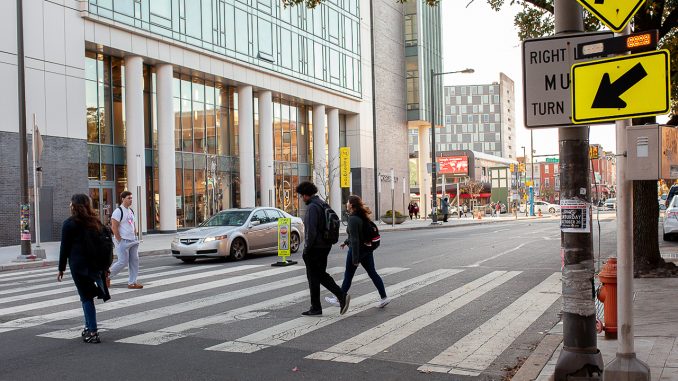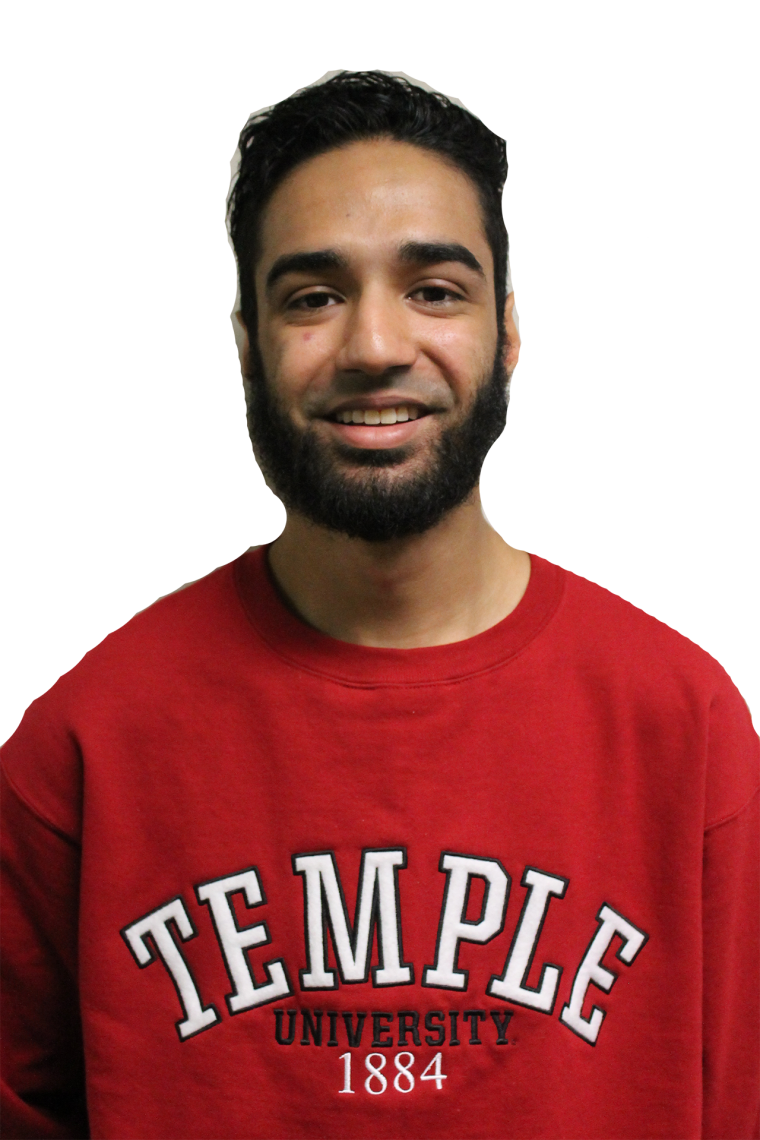

Last month, in a lunchtime trip to Qdoba, I took a few careful steps onto the crosswalk leading to Morgan Residence Hall when a car came barreling toward me on Cecil B. Moore Avenue.
I immediately stopped, petrified of the oncoming vehicle, but in retrospect, I know that if I took a few more steps, the car would’ve hit me.
Only minutes later, as I walked back to campus, the same thing happened.
In both cases, there was a small sign telling vehicles to yield to pedestrians. Either it wasn’t visible, or the drivers didn’t care; regardless, it shows how dangerous campus can be for pedestrians.
There were 42 pedestrian traffic fatalities in Philadelphia last year — an increase from 38 in 2017 and 36 in 2016 — according to the Bicycle Coalition of Greater Philadelphia. In fact, Philadelphia has a higher rate of traffic deaths per capita than New York City, Los Angeles or Boston, according to Vision Zero, a road safety project.
The intersection of Cecil B. Moore and Broad was named one of the most dangerous intersections in Philadelphia by Vision Zero, with 13 pedestrian-involved crashes between 2009 and 2013.
Vision Zero’s High Injury Network, which highlights Philadelphia streets with high rates of traffic incidents, also cites Cecil B. Moore Avenue and Norris Street — two streets cutting through Main Campus — as having a large number of traffic-related injuries and deaths.
Madison Smith, a freshman health professions major, experienced this in August when she was nearly struck by a speeding car that hit a pothole and crashed into a planter on the sidewalk outside of Honeygrow at this intersection, where she was eating outside that day.
“My adrenaline was pumping and I was just frozen,” Smith said. “It was kind of like that feeling of ‘did this just happen?’”
On April 9, 2015, PennDOT launched a media campaign for pedestrian safety from the intersection of Broad and Cecil, alongside a push for greater traffic enforcement from Temple and Philadelphia Police Department, The Temple News reported.
It seems as though this initiative has only yielded moderate traffic signage in this area: a short sign telling drivers to stop for pedestrians within the crosswalk alongside some flashing orange lights that only appear at night, which is a state law already.
On April 29, 2015, only 20 days after PennDOT announced this initiative for heightened pedestrian safety, Rachel Hall, a 2016 sociology and criminal justice alumna, was struck and later hospitalized by a vehicle in a hit-and-run at Broad and Diamond Streets — three blocks from Cecil B. Moore.
It was later reported that there was not a crosswalk at the intersection of Hall’s accident, and the city did not pave one until August, months after the hit-and-run. The city was also unaware that a stop sign had been stolen a block away from her collision until September, The Temple News reported.
Despite the fact these two traffic failures endangered the lives of other students in the months following Hall’s collision, it seems as though the city did not respond with real solutions in an expeditious fashion.
Obviously, part of the blame falls on drivers, as speed and distracted driving are two of the greatest contributors to traffic fatalities in Philadelphia, WHYY reported in 2018.
But given the city’s lack of genuine oversight of traffic signs in these cases, it’s clear that the issue is more nuanced than simply telling drivers to slow down and stop texting.
To their credit, the university and the city recently collaborated on a project to install speed cushions, paint new crosswalks and designate traffic guards at high-traffic areas on 12th Street between Norris Street and Montgomery Avenue, said Charles Leone, executive director of campus safety services.
But this isn’t the only area where a change in traffic mitigation is necessary: Cecil B. Moore Avenue, is a bigger threat to pedestrian safety.
“We’ll do some selective enforcement between us and the City of Philadelphia, get drivers on board with driving slower, issuing citations if we have to, just to get the message out,” Leone said of enforcement at Cecil B. Moore Avenue.
Richard Montanez, deputy commissioner of transportation for the Philadelphia Streets Department, said that the city has communicated with Temple to increase visibility and safety at the Temple University Regional Rail station, but that any further plans for Cecil B. Moore Avenue are Temple’s responsibility to enforce.
“The [Philadelphia] Streets Department is not an enforcement agency,” Montanez said. “We’re a regulatory agency: we set rules, we put up signage, we do things like that.”
While I appreciate the efforts for greater pedestrian safety measures in other parts of campus, the areas that are most in need of more visible signs and heightened enforcement are seemingly ignored. And while both the city and university state hypothetical plans or initiatives to make streets safer, their track record doesn’t necessarily suggest that this will turn out successful.
I want our streets to be safe for pedestrians, and while I understand that these measures take time, due to extensive research and funding involved, I’m not interested in waiting that long.
I don’t want to have to risk my life crossing the street while I wait for Temple and the city to figure out what to do.


I think the people walking and biking need to step up and start obeying the rules. OOPS! The city is intent on sticking it to drivers, without using proper traffic engineering.
There is a Streets That Work program by the National motorists Association you should evaluate.
Let’s not forget the small side streets near Temple University Station. They’re like bowling alleys for pedestrians, with cars flying down streets, refusing to stop for anything – a human being, a sign, whatever.
Many of these streets do not have traffic lights, leaving pedestrians and motorists to work it out for themselves. And there are too many motorists in that area who don’t care about a stop sign.
Even some SEPTA buses refuse to wait for students to cross streets, impatiently pushing through them, nearly hitting them.
I think the real answer is to have more crossing guards/traffic cops. Signs get stolen or ignored; lights are ignored. And more speed cushions is also an idea. Stick it to the drivers, indeed – they’re the ones operating the several-ton monstrosities that can easily kill people. And way too often, they act as though they can bully pedestrians.